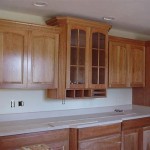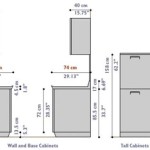Essential Aspects of Minimum Distance Between Upper and Lower Kitchen Cabinets
The minimum distance between upper and lower kitchen cabinets is a crucial design element that affects both the functionality and aesthetics of your kitchen. Optimizing this distance ensures comfortable movement, efficient storage, and an overall cohesive design. This article delves into the essential aspects that determine the ideal minimum distance, providing insights for a well-planned and practical kitchen.
Factors to Consider:
- Height of users: The primary users of the kitchen should be able to comfortably reach both upper and lower cabinets without straining or bending excessively. A standard distance of 18-24 inches between the countertop and the bottom of the upper cabinets allows for easy access.
- Countertop thickness: The thickness of the countertop affects the overall height of the lower cabinets. Thicker countertops require a slightly larger minimum distance to avoid collision with the top of the upper cabinets. Consider an additional 1-2 inches for countertops thicker than 1.5 inches.
- Upper cabinet depth: Deeper upper cabinets extend further into the kitchen space, necessitating a larger minimum distance to prevent them from protruding too far and obstructing movement. A minimum distance of 15-18 inches is recommended for upper cabinets with a depth of 12 inches or more.
- Appliances and backsplash: If appliances such as microwave ovens or dishwashers are installed beneath the upper cabinets, a larger minimum distance is required to accommodate their height. Additionally, the presence of a backsplash on the wall behind the countertop may slightly reduce the available space, requiring a corresponding adjustment to the minimum distance.
- Aesthetic preferences: While functionality is paramount, aesthetics also play a role in determining the minimum distance. A larger distance can create a more spacious and open feel, while a smaller distance can make the kitchen appear more cozy and intimate. Consider the overall design style and personal preferences when making this decision.
Conclusion:
Optimizing the minimum distance between upper and lower kitchen cabinets requires careful consideration of various factors. By understanding the essential aspects outlined above, you can create a kitchen that maximizes functionality, enhances accessibility, and aligns with your aesthetic preferences. These guidelines ensure a well-conceived design that contributes to a comfortable and efficient cooking and living space.

Your Kitchen Renovation Measured For Perfection Rona

Best Practices For Kitchen Space Design Fix Com

Do Instructions Result In 18 Between Counter Top And Upper

Best Practices For Kitchen Space Design Fix Com

Kitchen Standard Dimensions Essential Measurements

Height Between Upper Cabinets And Counters Kitchen Elevation

Kitchen Space Design Code And Best Practices Pride News

10 Kitchen Space Rules To Follow Immediately For A Phenomenal Set Up Arch2o Com

N Kitchen Dimensions Standard Sizes For Every Last Detail The Interiors Addict

How Much Space Between Countertop And Upper Cabinets
Related Posts








